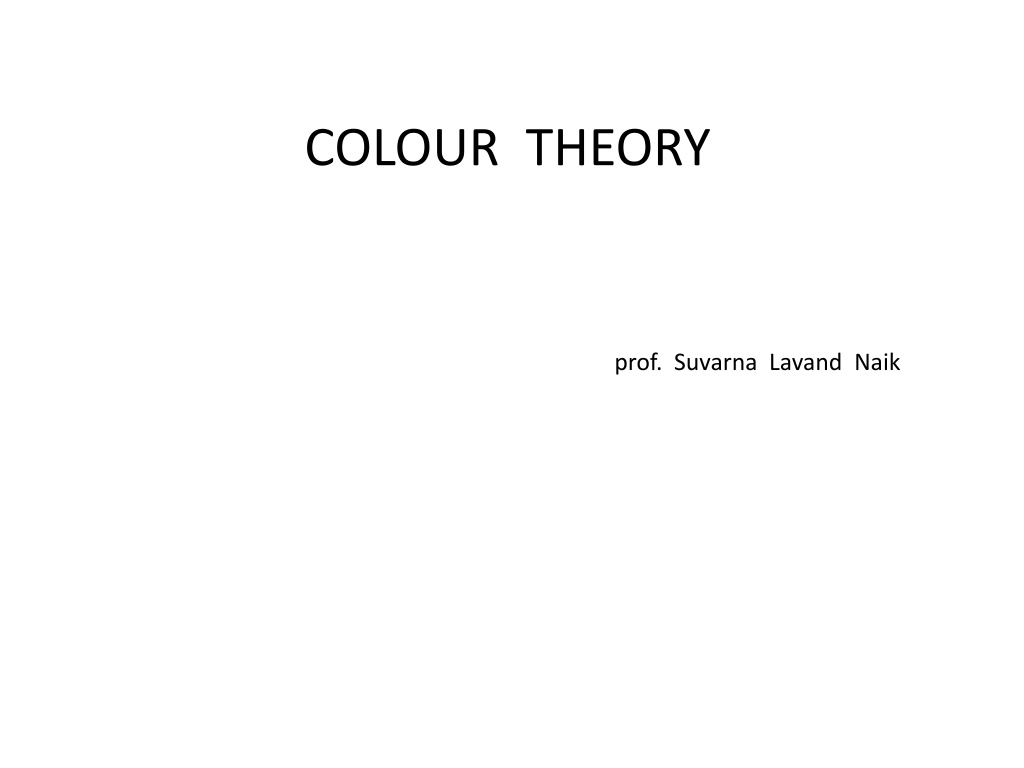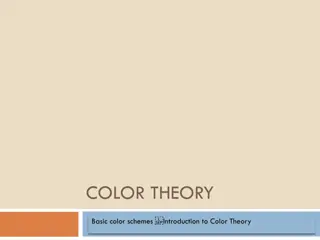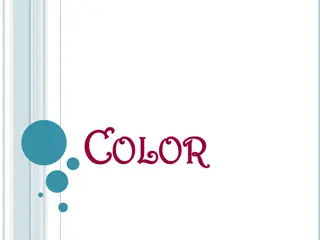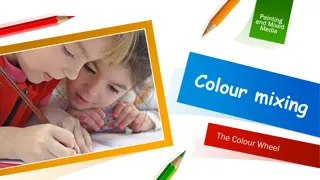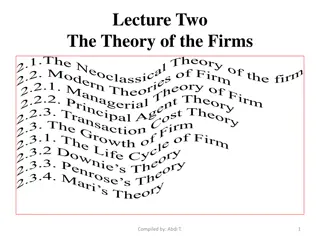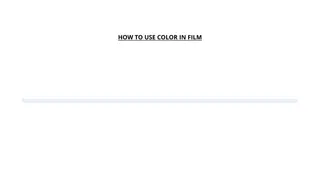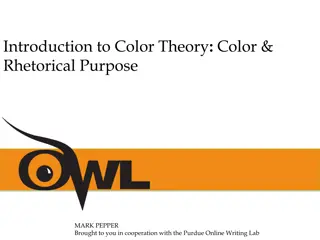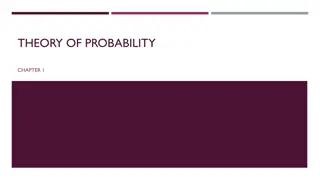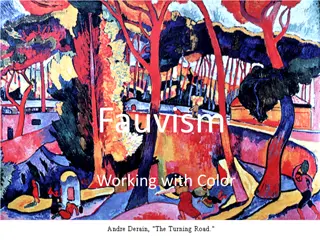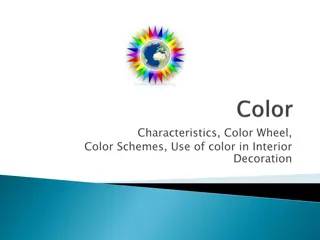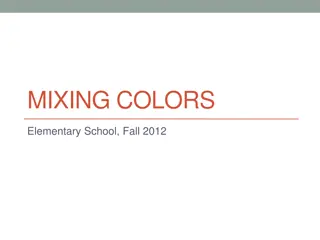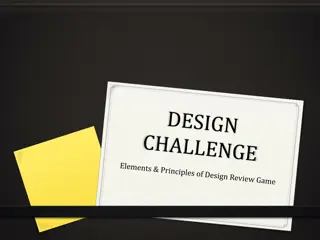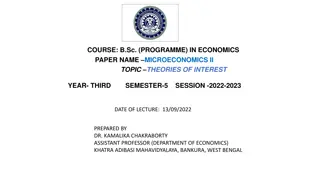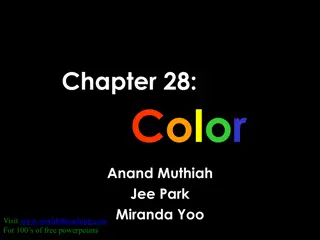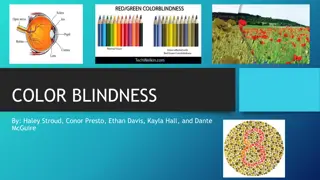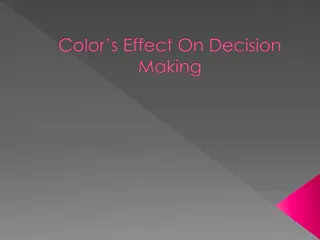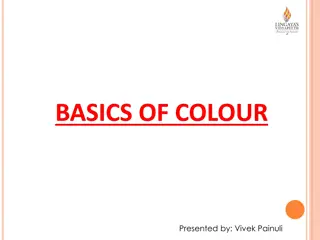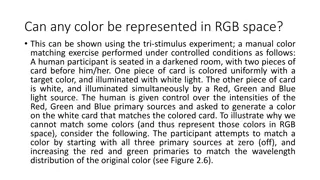Color Theory: Basics and Applications
Color theory encompasses the color wheel, color harmony, and how colors are used. It provides a logical structure for organizing and creating colors. Primary, secondary, and tertiary colors play key roles in this theory, along with concepts like color harmony and context. By understanding color theory, you can effectively use colors in various design applications.
Download Presentation

Please find below an Image/Link to download the presentation.
The content on the website is provided AS IS for your information and personal use only. It may not be sold, licensed, or shared on other websites without obtaining consent from the author. Download presentation by click this link. If you encounter any issues during the download, it is possible that the publisher has removed the file from their server.
E N D
Presentation Transcript
COLOUR THEORY prof. Suvarna Lavand Naik
There are three basic categories of color theory that are logical and useful : The color wheel, color harmony, and the context of how colors are used. The color wheel, color harmony, and the context of how colors are used. Color theory encompasses a multitude of definitions, concepts and design applications - enough to fill several encyclopedias. However, there are three basic categories of color theory that are logical and useful : The color wheel, color harmony, and the context of how colors are used. Color theories create a logical structure for color. For example, if we have an assortment of fruits and vegetables, we can organize them by color and place them on a circle that shows the colors in relation to each other.
The Color Wheel The color wheel is divided into three categories: primary, secondary, and tertiary. The three primary colors primary colors are red, yellow and blue. These colors are considered to be foundation colors because they are used to create all other colors.
Primary Colors In traditional color theory (used in paint and pigments), primary colors are the 3 pigment colors that cannot be mixed or formed by any combination of other colors. All other colors are derived from these 3 hues. Primary Colors: Red, yellow and blue Secondary Colors These are the colors formed by mixing the primary colors. Secondary Colors: Green, orange and purple Tertiary Colors: blue-purple, blue-green & yellow-green These are the colors formed by mixing a primary and a secondary color. That's why the hue is a two word name, such as blue-green, red-violet, and yellow-orange. Color Harmony Tertiary Colors: Yellow-orange, red-orange, red-purple,
PRIMARY COLOUR Red, Yellow Blue.
SECONDARY COLOUR Green, orange 1 Orange- Red 2. Green 3. Purple Red into Yellow Blue into Yellow Purple/Violet Yellow. Green- Mix Blue Violet- Mix Red Yellow. Red into Blue Blue. purple
TERTIARY COLOUR The six tertiary colors combining a primary and an adjacent secondary color. These colors are 1 Yellow orange 2 red-orange, 3 Red violet 4 Blue violet 5 blue-green 6 Yellow green tertiary colors are made by
Color Terms Color Harmony: using colors in a pleasing way. Color Scheme: the make up of colors Hue: color, any color Intensity: the brightness and dullness of a color Value: the lightness or darkness of a color.
Value A tint of a color is made by adding white. A shade is made by adding black. Toning is made by adding gray.
Intensity Intensity (also called chroma or saturation) is the brightness or dullness of a color on a color wheel is at full intensity (bright). When we mix it with gray, black, or white, it becomes dull. Colors also lose intensity when mixed with their complement (the opposite color on the wheel). the brightness or dullness of a color. A color as we see it
HUE Hue refers to the origin of the color we see. Think of the Hue as one of the six Primary and Secondary base color of the mixture either Yellow, Orange, Red, Violet, Blue or Green. Primary and Secondary colors. base color of the mixture you're looking at is Yellow, Orange, Red, Violet, Blue or Green. colors. In other words, the underlying underlying
COLOR SCHEME Complimentary Double complimentary Split complimentary Terad Triadic Polychromatic Monochromatic Analogous Neutral Acrobatic Warm color Cool color
Complementary Colors If two hues are opposite each other on the color wheel they are considered to be complementary colors. When used together in a design they make each other seem brighter and more intense. (example: red and green) Mixed together makes brown
Split Complementary This color scheme uses three colors: any hue and the two adjacent to its complement. (example: red, yellow-green, and blue-green)
Triadic This scheme also uses three colors. They are evenly spaced from each other. (example: red, yellow, and blue)
Double Complement Made of colors that are adjacent to both direct complements. (example: yellow and violet, blue and orange)
Tetrad This scheme uses four colors evenly spaced on the color wheel. A primary, secondary and two tertiary colors are used. (example: red, green, yellow-orange, and blue-violet)
Polychromatic Use any 4 or more colors from the colors wheel.
Polychromatic Use any 4 or more colors from the colors wheel.
Monochromatic A color scheme using one color, and tints, tones and shades of that color. Blue Blue-violet Blue-green Violet Green Red-violet Yellow-green Red Yellow Red-orange Yellow-orange Orange
Analogous A color scheme using colors next to each other on the color wheel. Blue Blue-violet Blue-green Violet Green Red-violet Yellow-green Red Yellow Red-orange Yellow-orange Orange Note that even though these are very bright hues of 5 colors next to each other on the color wheel, that they are analogous, even though they are bright.
Neutral A color scheme using whites, blacks, grays and beiges.
Warm and cool color Colors on the warm side of the spectrum red, yellow, orange Colors on the cool side of the spectrum blue, violet, green.
Choosing Color Schemes Select your favorite color Add to an established color scheme Select colors based on the feelings or mood you wish to create. Evaluate parts of the room that cannot be changed, then consider color choices that will complement existing furnishings. Select colors that complement a particular work of art (quilt, favorite picture, etc.) Select colors that complement a chosen fabric or wallpaper.
